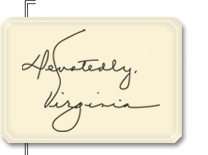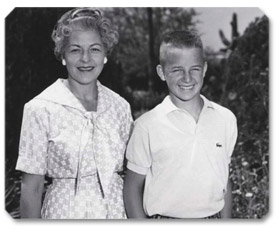|
CHAPTER TWO Dawn, second of the Galvin children, remembers a "very beautiful, strict lady, a lady of the old-fashioned school" whom she had always wanted to emulate. "She was very soft-spoken but used big, hundred-thousand-dollar words, constantly improving her vocabulary. She always looked perfect and was very disciplined; she had her list of accomplishments set out for the day, and she never failed to achieve each of them." Christopher Galvin, the third born, offers the following description of his step-grandmother: She was very nice, very gracious, and very warm, a grandmotherly figure, a handsome woman, soft-spoken, quiet, engaging, always interested in one's activities, and sensitive and embracing of young people, whom she enjoyed. She was a classic, first-class kind of grandmother figure, always present at our events. Paul passed away when I was nine, in 1959, so I mainly knew them together from the vantage point of grammar school and kindergarten. Like Paul, Virginia was always interested in your grades, your projects, always accommodating of the little entrepreneurial things. One story Paul used to tell about me when I was young is how I wanted to have my own paper route. I would go around the house picking up magazines and trying to sell them. Paul would buy one, and he and Virginia would always humor me. Michael Galvin, born in 1952, when his grandfather and Virginia had been married seven years, also remembers his step-grandmother. "She was adored and respected by Paul, warm, welcoming, always a part of our family in the traditional sense of holidays,Thanksgiving, Christmas, Easter, birthdays." He recalls sitting on her lap and opening gifts and her formal style of dress. He never saw her in a bathing suit, bathrobe, or shorts; she dressed in an understated, refined way. Looking back, he realizes how superbly she navigated between her professional world as Mrs. Paul Galvin and her role as grandmother, how important a figure she was in forming his own view of women as strong and fully substantive in their professional bearing but also feminine, graceful, and beautiful. Virginia's relationship with her parents, Ken and Jessica, continued to be unusually close even as her own status dramatically altered. Ken now earned a comfortable income in refrigeration engineering for large buildings in Chicago, while Jessica continued to enjoy playing the hundreds of songs she had memorized from her days as an accompanist for silent movies. The Critchfields enjoyed an unpretentious, middle-class lifestyle, and Virginia never failed to invite them to social functions she thought they would enjoy. Indeed, throughout her life, even when her visibility as a philanthropist grew, she consistently welcomed them into her own very public life, a tribute to her loyalty and upbringing and a demonstration of pride in her own background. Virginia maintained a cordial relationship with her stepson, his wife, and their growing children. She also attended a constant round of gala events, charity balls, black-tie affairs, and corporate functions, activities required of the wife of the president of Motorola. To her credit, Virginia was a quick study, interested in her own self-improvement. Inquisitiveness was one of the driving elements of her personality, whether it was curiosity about how something worked or a genuine, warm interest in other people. And being married to a man like Paul Galvin, there was much for Virginia to learn just to keep up with his constant ambition to build upon previous success and never grow complacent. Paul's ethic overlapped into a life ethos: never sit still; keep moving. Living with a man like him must have been stimulating, challenging, energizing, and occasionally exhausting; any inclinations toward learning Virginia already possessed had to have been, in the Galvin household, heightened and encouraged. Quite simply, Virginia adored Paul as much as he adored her, and she wanted him to be proud of her. Whether observing appropriate protocol within the higher echelons of Chicago society or being by Paul's side at family holidays, maintaining close ties with her own family, or creating new interests in Arizona, Virginia, always a "detail person," strove to be gracious, to be as knowledgeable and devoted in her manner and bearing as she could. And by all accounts, according to the recollections of those who knew her, she succeeded. Paul's son describes Virginia's hallmark qualities as he knew them in those days: My father, being twenty [sic] years older, was a far more mature human being: he had lived a significant life and had learned by doing; he was gifted in many ways and was constantly improving himself. Virginia, in comparison, had lived a slightly more sheltered life. So when these two came together, you could ascertain the differential. What you saw was a lady of fine qualities. She had worked at a doctor's office and was a professional lady doing admirable work that required organizational abilities. We were impressed that she'd had a good profession. But I don't think she'd had very many broadening experiences. She had decent experiences,her mother, father, and sister were very decent people,but with my father there came a different engagement with life. In 1945, the same year Virginia married Paul, Carol Critchfield, who had been earning a living as a fashion and children's book illustrator, married Arthur Irwin Jirka, an accomplished pianist and captain in the U.S. Army Dental Corps. Their only child, Paul, named after Paul Galvin, was born on September 24, 1946. "Little Paul," a precocious, ebullient child nicknamed "Smiley" by his friends, would grow up to be naturally gifted in music and athletics. His Aunt Virginia, who had no children of her own, cultivated a deep and loving interest in her sister's only child. In 1949, Carol, Arthur, and their son moved to Riverside, Illinois, where Paul's earliest memories of his "Aunt Gin" are of a wonderful, loving lady with a sense of decorum and great strength of character. Though Carol and Arthur divorced in 1955, when Paul was in the fourth grade, Carol and her son continued to live in the comfortable two-story home in Riverside, which Paul and Virginia had built for Carol and Arthur upon Arthur's return from the war. Divorce in the '50s was not as easily received or tolerated as it is today. There was still a certain stigma attached to the notion of a divorcee, which, in addition to Carol's slightly bohemian-artist personality, must have roused protective instincts in her older sibling. In fact, Carol would often refer to Virginia, or Gin, not only as her best friend but also as her "protector." Paul and Virginia generously helped Carol financially, so that as a single mother she could continue to use her talents as a children's-book and fashion-industry illustrator and to teach art classes, thereby earning a living through her artistic gifts,and Virginia frequently made the fifty minute drive from her home in Evanston to visit her sister and nephew. Following his mother's divorce, Little Paul's chief male role models became his uncle, "Big Paul," and his maternal grandfather, Ken. Riverside, "The Village in the Forest," was the first planned suburban community in America, a retreat designed for businessmen who could make the twenty-minute train commute into downtown Chicago each day and return to the peaceful, idyllic community designed by Frederick Law Olmsted, the landscape architect who designed Chicago's Columbian exhibition as well as Central Park in New York City. Originally an area of Indian trails along the banks of the Des Plaines River, then of wooden roads in the 1850s, Riverside, with the advent of the railroad, became a commuter community, boasting its own train station, water tower, America's first indoor shopping mall (the Arcade Building), village hall, library, ice cream parlor, swinging suspension bridge across the Des Plaines River and winding streets shaded by oak and elm trees. With plenty for children to do,skating on Swan Pond, sledding down Suicide Hill, and participating in Cub Scout activities and Little League games at Indian Gardens baseball field,Riverside afforded its children an old-fashioned, Norman Rockwell sort of childhood, and Paul Critchfield lived there from age three through his college years. According to longtime childhood friend, Ron Milnarik, now a dentist and teacher of dentistry at the University of Illinois Dental School, "Riverside was like a little train set village, where forty cents could buy you a model car kit, and you could go to Victory Lanes, a six-lane, pine-paneled bowling alley, and bowl three games for a dollar on Saturday mornings." Nestled in its forest of ancient oaks, maples, and elms, Riverside provided children a rare oasis of adventure and safety. Paul Critchfield remembers his own childhood as enchanted, with visits from his Aunt Gin,whether to attend one of his Little League games, to bring gifts at Christmas, or to simply drop in,adding to the magic. |
|
| About the Author l Pipertrust.org | |








